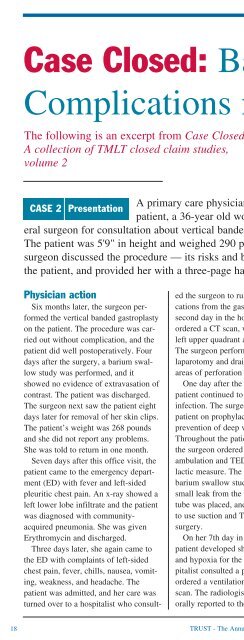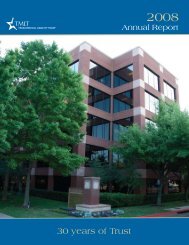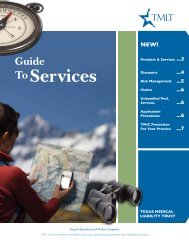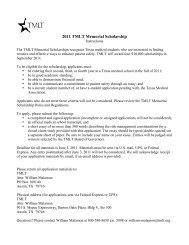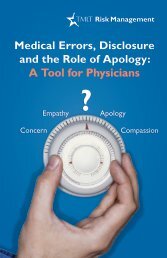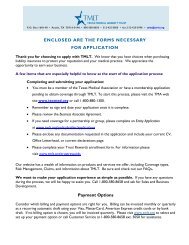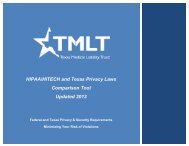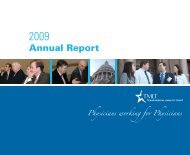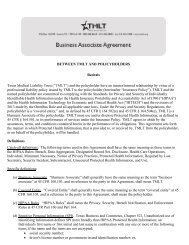Trust - TMLT
Trust - TMLT
Trust - TMLT
You also want an ePaper? Increase the reach of your titles
YUMPU automatically turns print PDFs into web optimized ePapers that Google loves.
Case Closed: Bariatric SurgeryComplications not RecognizedThe following is an excerpt from Case Closed:A collection of <strong>TMLT</strong> closed claim studies,volume 2A primary care physician referred hisCASE 2 Presentationpatient, a 36-year old woman, to a generalsurgeon for consultation about vertical banded gastroplasty.The patient was 5'9" in height and weighed 290 pounds. Thesurgeon discussed the procedure — its risks and benefits — withthe patient, and provided her with a three-page handout.Physician actionSix months later, the surgeon performedthe vertical banded gastroplastyon the patient. The procedure was carriedout without complication, and thepatient did well postoperatively. Fourdays after the surgery, a barium swallowstudy was performed, and itshowed no evidence of extravasation ofcontrast. The patient was discharged.The surgeon next saw the patient eightdays later for removal of her skin clips.The patient’s weight was 268 poundsand she did not report any problems.She was told to return in one month.Seven days after this office visit, thepatient came to the emergency department(ED) with fever and left-sidedpleuritic chest pain. An x-ray showed aleft lower lobe infiltrate and the patientwas diagnosed with communityacquiredpneumonia. She was givenErythromycin and discharged.Three days later, she again came tothe ED with complaints of left-sidedchest pain, fever, chills, nausea, vomiting,weakness, and headache. Thepatient was admitted, and her care wasturned over to a hospitalist who consultedthe surgeon to rule out any complicationsfrom the gastroplasty. On hersecond day in the hospital, the surgeonordered a CT scan, which revealed aleft upper quadrant abdominal abscess.The surgeon performed an exploratorylaparotomy and drained the abscess. Noareas of perforation were noted.One day after the laparotomy, thepatient continued to have fever andinfection. The surgeon started thepatient on prophylactic Heparin for theprevention of deep venous thrombosis.Throughout the patient’s hospital stay,the surgeon ordered early and frequentambulation and TED hose as a prophylacticmeasure. The surgeon ordered abarium swallow study, which showed asmall leak from the stomach. An NGtube was placed, and the surgeon optedto use suction and TPN to avoid furthersurgery.On her 7th day in the hospital, thepatient developed shortness of breathand hypoxia for the first time. The hospitalistconsulted a pulmonologist, andordered a ventilation/perfusion lungscan. The radiologist read the scan andorally reported to the hospitalist that itwas negative for pulmonary embolism.However, the radiologist’s writtenreport indicated “low to indeterminatefor possible pulmonary embolism.”This report was not read by the hospitalistuntil ten days later. In retrospect,the hospitalist indicated that if he hadknown about this finding, he wouldhave started the patient on Heparin orplaced a Greenfield filter.The patient’s conditioned worsened,and she was returned to the OR. The18 TRUST - The Annual Report Magazine


